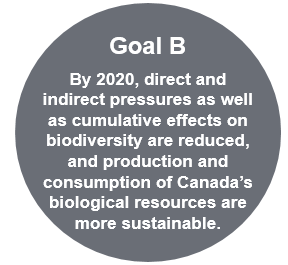Canada Target 13. By 2020, innovative mechanisms for fostering the conservation and sustainable use of biodiversity are developed and applied.
About the Target
Successfully safeguarding biodiversity requires a broad range of strategies and tools to drive innovation, foster collaborative or multi-sectoral approaches, and support sustainable use of resources. It entails different kinds of knowledge including the physical and social sciences as well as traditional and practitioner knowledge. It can also include the use of economic instruments or other incentives to encourage meaningful conservation practices and sustainable use of biodiversity by households and organizations.
Canada has a strong record of innovation to achieve biodiversity goals. For example, measures for the protection of ecologically sensitive lands beyond simple acquisition, such as land trusts and ecological tax incentives, are well established and involve collaboration among all levels of government and non-governmental organizations. New economic instruments, innovative technologies and changes to patterns of consumption and production can conserve and enhance biodiversity while contributing to overall sustainability.
Canada Target 13 is linked with the following global Aichi target under the United Nations Convention on Biological Diversity Strategic Plan for Biodiversity 2011-2020: :
Aichi Target 3 - By 2020, at the latest, incentives, including subsidies, harmful to biodiversity are eliminated, phased out or reformed in order to minimize or avoid negative impacts, and positive incentives for the conservation and sustainable use of biodiversity are developed and applied, consistent and in harmony with the Convention and other relevant international obligations, taking into account national socio economic conditions.
Aichi Target 4 - By 2020, at the latest, Governments, business and stakeholders at all levels have taken steps to achieve or have implemented plans for sustainable production and consumption and have kept the impacts of use of natural resources well within safe ecological limits.
2020 Final Assessment
Canada’s 6th National Report to the CBD provided case studies which are illustrative of the range of innovative mechanisms that have been developed and applied.
The target was met as innovative mechanisms were developed and applied. The use and application of innovative mechanisms for the conservation and sustainable use of biodiversity has accelerated, broadened and deepened, with a large number of voluntary multi-stakeholder initiatives whereby non-governmental actors come together to work across sectors to find mutually beneficial solutions to often challenging issues.
Contributing Actions
Canada’s Ecological Gifts Program provides a way for Canadians with ecologically sensitive land to protect nature and leave a legacy for future generations. Made possible by the terms of the Income Tax Act of Canada and the Quebec Taxation Act, it offers significant tax benefits to landowners who donate land or a partial interest in land to a qualified recipient. Recipients ensure that the land’s biodiversity and environmental heritage are conserved in perpetuity. Between the inception of the program in 1995 and March 31, 2021, 1,610 ecological gifts valued at over $977 million have been donated across Canada, protecting over 211,000 hectares of wildlife habitat.
The Deshkan Ziibi Conservation Impact Bond (DZCIB) is a "pay-for-success" conservation finance model where conservation is funded upfront through impact investors who receive a return-on-investment paid by the final funders of the work (“outcome payers”) contingent on success in conservation outcomes. In the autumn of 2021, Environment and Climate Change Canada provided funding to extend the pilot to strategically accelerate wildlife and habitat conservation in one of Canada’s priority places, Long Point Walsingham Forest.
When the Thaidene Nene National Park Reserve was established in 2019, a $30 million trust fund was created with matching funds from the federal government and philanthropic support raised by the community in partnership with Nature United. The trust fund generates about one million dollars annually for operational costs including Guardians, training, and management.
The Cheakamus Community Forest (CCF) in British Columbia sells carbon credits to voluntary market buyers. CCF is on Crown land and the tenure is held by the Lil’Wat and Squamish First Nations and the Regional Municipality of Whistler, with non-profit and private consulting organizations helping to plan, create, and market credits. CCF generates credits by reducing its timber harvest, increasing the proportion of old trees, and leaving more rare ecosystems and areas near rivers intact.
Certification systems such as the Sustainable Forestry Initiative and the Forest Stewardship Council or awards such as the BC Conservation & Biodiversity Awards established in 2020 are ways to recognize and financially support conservation based initiatives or encourage sustainable practices.
The Municipal Natural Assets Initiative (MNAI) was established to refine, test and scale up natural asset management work that was first initiated by the Town of Gibsons (BC). The MNAI is testing how to manage natural assets such as woodlands, wetlands, and creeks in urban areas as part of a sustainable infrastructure strategy. This approach identifies and determines the value of natural assets, and accounts for their contribution to municipal government services delivery—services that would otherwise need to be delivered by engineered assets. The initiative is changing the way in which municipalities across Canada deliver services while increasing the quality and resilience of natural infrastructure in the face of climate change at lower costs and reduced risk.

